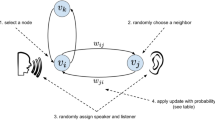Abstract
We develop a parsimonious framework for evaluating the efficacy of different approaches for limiting the spread of misinformation. We use this framework and simulation studies to determine the evolution of truthful and fake messages on social media platforms and then investigate the following policy interventions: (1) our suggested approach of having the platform require senders of messages to also state their perceived (possibly incorrect) veracity of the message, (2) provide some accuracy nudge to increase the number of potential readers who can accurately identify fake messages, (3) have the platform flag fake messages, and (4) have the platform demote or down-rank fake messages. We find that when a significant number of senders are able to correctly identify the veracity of the message, the market can self-regulate under our suggested approach. If this is not the case, we find that augmenting our approach with any of the other approaches is effective in reducing the spread of misinformation.


Similar content being viewed by others
Data Availability
The simulation code is available upon request from the authors.
Notes
Note, person type is message specific, i.e., a person can be sophisticated for one message but naive for another.
Our main results on the reading and posting dynamics of fake messages remain valid even without specifying a particular relationship between \({P}_{T}^{N}\) and \({P}_{F}^{N}\).
Plots on the extensions for these three interventions are in the Online Appendix.
References
Acemoglu, D., Ozdaglar, A., & Siderius, J. (2023). A Model of online misinformation. Review of Economic Studies.
Allcott, H., & Gentzkow, M. (2017). Social media and fake news in the 2016 election. Journal of Economic Perspectives, 31(2), 211–236.
Anderson, E. T., & Simester, D. I. (2014). Reviews without a purchase: Low ratings, loyal customers, and deception. Journal of Marketing Research, 51(3), 249–269.
Stewart, A. J., Arechar, A. A., Rand, D. G., Plotkin, J. B. (2023). The game theory of fake news. (https://arxiv.org/abs/2108.13687)
Deng, Y., Staelin, R., Wang, W., & Boulding, W. (2018). Consumer sophistication, word-of-mouth and “false” promotions. Journal of Economic Behavior & Organization, 152, 98–123.
Fong, J., Guo, T., Rao, A. (2023). Debunking misinformation about consumer products: Effects on beliefs and purchase behavior. Journal of Marketing Research, 0(0). https://doi.org/10.1177/00222437221147088
He, S., Hollenbeck, B., & Proserpio, D. (2022). The market for fake reviews. Marketing Science, 41(5), 896–921.
Lazer, D. M. J., Baum, M. A., Benkler, Y., Berinsky, A. J., Greenhill, K. M., Menczer, F., Metzger, M. J., Nyhan, B., Pennycook, G., Rothschild, D., et al. (2018). The science of fake news. Science, 359(6380), 1094–1096.
Pennycook, G., & Rand, D. G. (2021). The psychology of fake news. Trends in Cognitive Sciences, 25(5), 388–402.
Pennycook, Gordon, Epstein, Ziv, Mosleh, Mohsen, Arechar, Antonio A., Eckles, Dean, & Rand, David G. (2021). Shifting attention to accuracy can reduce misinformation online. Nature, 592(7855), 590–595.
Rao, A. (2022). Deceptive claims using fake news advertising: The impact on consumers. Journal of Marketing Research, 59(3), 534–554.
Staelin, R., Urbany, J. E., & Ngwe, D. (2023). Competition and the regulation of fictitious pricing. Journal of Marketing, 87(6), 826–846. https://doi.org/10.1177/00222429231164640
Vosoughi, S., Roy, D., & Aral, S. (2018). The spread of true and false news online. Science, 359(6380), 1146–1151.
Walter, N., Jonathan Cohen, R., Holbert, L., & Morag, Y. (2020). Fact-checking: A meta-analysis of what works and for whom. Political Communication, 37(3), 350–375.
Ward, A. F., Zheng, J., & Broniarczyk, S. M. (2023). I share, therefore I know? Sharing online content-even without reading it-inflates subjective knowledge. Journal of Consumer Psychology, 33(3), 469–488.
Acknowledgements
The authors would like to thank Tong Guo, Charles Staelin, and Nils Wernerfelt for their useful comments. All errors are our own.
Author information
Authors and Affiliations
Corresponding author
Ethics declarations
Ethical approval
Not applicable.
Informed consent
Not applicable.
Conflict of interest
Not applicable.
Additional information
Publisher's Note
Springer Nature remains neutral with regard to jurisdictional claims in published maps and institutional affiliations.
Supplementary Information
Below is the link to the electronic supplementary material.
Rights and permissions
Springer Nature or its licensor (e.g. a society or other partner) holds exclusive rights to this article under a publishing agreement with the author(s) or other rightsholder(s); author self-archiving of the accepted manuscript version of this article is solely governed by the terms of such publishing agreement and applicable law.
About this article
Cite this article
Deng, Y., Staelin, R. Modeling misinformation spread for policy evaluation: a parsimonious framework. Mark Lett (2024). https://doi.org/10.1007/s11002-024-09724-8
Accepted:
Published:
DOI: https://doi.org/10.1007/s11002-024-09724-8




